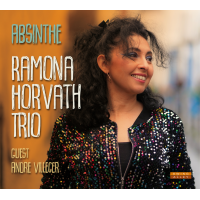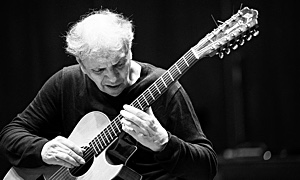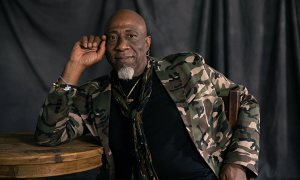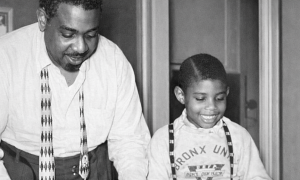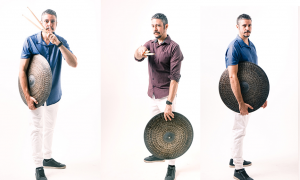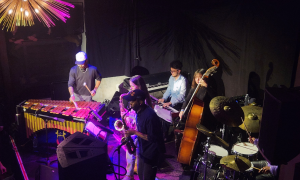Home » Jazz Articles » Interview » Rez Abbasi: Microtones, Fearlessness and the Fifteen-Step Process
Rez Abbasi: Microtones, Fearlessness and the Fifteen-Step Process
Compositionally, I
 India-born and California-raised, guitarist/composer Rez Abbasi—a resident of New York City for over a decade now—has been perfecting his own unique East-meets-West musical hybrid of Indian and jazz musics for some time. With the releases of Snake Charmer (Earth Sounds, 2005) and Bazaar (Zoho Music, 2006), he's perfected his formula, in part because his core group of drummer Danny Weiss, organist Gary Versace and vocalist Kiran Ahluwalia—supported on the former by master soprano saxophonist Dave Liebman and on the latter by several guest players—seems to be the perfect band to carry out the technical and emotional demands of Abbasi's compositions.
India-born and California-raised, guitarist/composer Rez Abbasi—a resident of New York City for over a decade now—has been perfecting his own unique East-meets-West musical hybrid of Indian and jazz musics for some time. With the releases of Snake Charmer (Earth Sounds, 2005) and Bazaar (Zoho Music, 2006), he's perfected his formula, in part because his core group of drummer Danny Weiss, organist Gary Versace and vocalist Kiran Ahluwalia—supported on the former by master soprano saxophonist Dave Liebman and on the latter by several guest players—seems to be the perfect band to carry out the technical and emotional demands of Abbasi's compositions.It's not debatable that Abbasi's music is jazz; no listener could hear its fierce improv-growing-out-of-themes and open-ended flexibility and place it in any other category—Abbasi's core band is, after all, a guitar-organ-drums trio. But the music is more than simply flavored with a few exotic Indian-music ingredients; rather, the rigorous time signatures and the self-imposed scalar distillations of Indian music are completely integral to the compositions and performances. Add the microtonalities of vocalist Ahluwalia, and you've got one of the most convincing and successful musical fusions of recent years.
Of course, Abbasi's a searing yet deeply melodic guitarist as well, who's performed as a sideman with Kenny Werner, Barre Philips, Dave Douglas and Peter Erskine—just to name a few. He's a member of bassist David Phillips' longstanding quartet Freedance and has established long-term musical associations with altoist Rudresh Mahanthappa, drummer Sunny Jain and saxophonist Dave Pietro, as well as serving as the musical director of his wife, Kiran Ahluwalia's ghazal music ensemble.
Abbasi spoke with me about his marvelous new CD, Bazaar, which was released at the end of 2006, as well as sharing his thoughts about his bandmembers, composition, improvisation, and whether there really is any movement of jazz musicians sharing Indian backgrounds.
Chapter Index
- Bazaar: Musicians and the "Fearless Factor
- Bazaar: the Tunes
- Gigging and the Sitar Guitar
- Freedance and Kiran Ahluwalia's Group
- Jazz Players of Indian Descent: a Movement?
- Influences
Bazaar: Musicians and the "Fearless Factor
All About Jazz: You have a new CD, Bazaar, out on Zoho, and I'm going to focus on this recording. This continues your work with your core band of organist Gary Versace and drummer Danny Weiss, plus vocalist Kiran Ahluwalia on several tracks, and it's a very good album.
I think the CD continues a very successful merger of jazz and Indian musics—which isn't to say there isn't some rock in there as well. The compositions are superb, and what impresses me the most, besides the group's cohesion and outright virtuosity, is how successful the blend of jazz and Indian elements is—a lot of people make music that fuses different musical styles, but it doesn't always work well, and here the combination is so organic. Something like "Leather, just to name one, is both deeply jazzy and profoundly un-western at the same time, and I'm always noticing the way the music moves between the specific rhythmic time signatures of Indian musics and the shifting, less specific tempi of jazz.
This album has the four musicians I mentioned—the core group—plus Gautam Siram on mridnagam, Rudresh Mahanthappa on alto, and Marc Mommaas on tenor/soprano (plus the whistling of Naren Budhakar on "Bazaar ) on specific tracks. I love the way these additional voices augment the core ensemble, and it provides a wonderful variety to the album that just feels like a natural development of the music. That's a lot for me to say, but tell me what you wanted to accomplish with this recording and how it might differ from the previous CD, Snake Charmer.
Rez Abbasi: Well, definitely, the band evolves as we play. But also, compositionally, things are a little different. Knowing what the strengths and weaknesses of the band are as a core unit is something you learn over time. I don't really write for the strengths or weaknesses of any particular band, but just knowing those strengths and weaknesses subconsciously is a good thing. And I think that has sort of penetrated the music and helped it to grow. As you play various festivals and shows, you learn more about potentials that you didn't think of before, surprises that come up.
Also, this particular band has so much potential that I can continue to write anything for it and it will come out sort of sounding like it's for the band. I don't really have to write to the band; I can write anything that I feel like writing and present it to the band, and because we've been working together for three-and-a-half years, or whatever it is, it will definitely merge together and fulfill its own role. AAJ: It's not all that common to have the same band for an extended time in this music.
AAJ: It's not all that common to have the same band for an extended time in this music.
RA: Well, yeah. Danny and Gary especially are very busy. Kiran is my wife, so [laughing] I can usually get her. I just tell her a little in advance and she's there. But the other guys—I've had subs for the band, for sure. And it's actually pretty fun having subs as well, because they bring a different light to the music. I don't want them to cop what's on the record—I just want them to know the tunes. It all just gives me more information, more stuff in my arsenal to produce more music.
AAJ: I want to ask about the specific players, because this is such a great band and everyone seems so attuned to each other and to your musical intentions. Obviously, first we have Gary and Danny, because ultimately this is a guitar-organ-drums trio. Danny is frighteningly good in this band—his kit and tabla work accomplish the very technical demands of your music, but at the same time, he's fearless—he knows this music and he's incredibly creative and intuitive within it. Tell me what he adds to your music.
RA: Well, everything that you just said, basically. The fearless factor—not the fear factor, but the fearless factor [laughing]—is one that is very important for all of us to make music that's unstifled. He knows what his limitations are for a particular composition—for whatever particular composition he's playing. And he seems to get there pretty often. I like that it's his own experience he's using; he makes the music his own. It's not like, "Hey, I'm a sideman on someone's gig. And I've noticed that with pretty much every band he plays with—if he likes the band, if he likes the players, if he gets along with everybody.
And Gary's the same way. There's no difference between those two guys in that sense. Gary also is very keen on supplementing the music with anything and everything, and at the same time he's cautious. A combination of throwing combination to the wind and yet somehow being a little cautious about what the music wants and calls for. It's a little paradoxical, I guess.
AAJ: Yes, but I know what you mean. A lot of groups with guitar and organ can be pretty bombastic—not that that's bad. But there is a spaciousness to your music despite these two instruments, and I think that Gary is very willing to play quietly and subtly when the music calls for it. His bass lines are powerful, but they are seldom dominant.
RA: Absolutely. And Danny is pretty dynamic in his nature also. He knows how to lay it back as well.
AAJ: This band plays with a lot of dynamics.
RA: Yeah, yeah. That's for sure. And with Kiran in the mix, the dynamic element can be emphasized even more.
AAJ: Kiran provides vocals on three pieces on this record. But that isn't to say she's not all over this record. She provides another voice, but to me, the microtonalities in her singing really underline the Indian element, and so do Rudresh's alto lines when he's playing. That's important, because you're not a microtonal player; you play a fretted instrument and you're not much of a string-bender.
RA: Exactly. I'm glad you noticed that. And that's part of the reason I wanted an Indian vocalist even before I met her: I wanted that microtonal aspect. I'll take it a step back. With Indian music, there are two engaging elements: one is rhythm and one is the microtonal aspect. I've delved into the rhythmical aspect—I studied tabla for a little bit, and I can put that into my music. No problem. But the microtonal element—like you said, on the fretted guitar, it's virtually impossible to come up with the kind of microtones that an Indian sitarist comes up with. You can't bend that much anyway, and if you bend, it just sounds more like a blues player anyway. That's why I don't tend to bend strings that much. It's more of a "slidy thing.
But when it comes to having a microtonal element in the band, instead of hiring a sitarist or violinist or something like that, I thought a vocalist would help the music bring that sound out. And I still think that. And that's kind of Kiran's function in a way: To go from the inner notes of the melody and extract the microtones and give it a different texture altogether.
class="f-right">
Bazaar: the Tunes
AAJ: Let's discuss some of the individual songs.
"Thin Elephant is actually quite a long piece at nine minutes, but every time I listen to it, it feels much shorter—I think because there's no time wasted. There's a beauty to this piece that I find very wise.
RA: Oh, I love that phrase—a "wise beauty.  AAJ: While the song can be separated into separate sections, that arpeggiated five-note phrase you play in the intro seems the key to the whole piece, and underlines all the sections. I really love the piece for its overall symmetry, its very elegant structure, and I like how your acoustic guitar solo goes from an almost raga-ish quality in the beginning to a romantic, even flamenco quality farther on. Danny's tabla work in the intro is as good as his kit work afterwards. Tell me about this one.
AAJ: While the song can be separated into separate sections, that arpeggiated five-note phrase you play in the intro seems the key to the whole piece, and underlines all the sections. I really love the piece for its overall symmetry, its very elegant structure, and I like how your acoustic guitar solo goes from an almost raga-ish quality in the beginning to a romantic, even flamenco quality farther on. Danny's tabla work in the intro is as good as his kit work afterwards. Tell me about this one.
RA: It first started with that chordal, motivic thing you mentioned. A lot of my compositions start with just a clear emotional vision; once I get that, I know I'll get a piece. So I knew this one had potential, and didn't want to just have an ABA kind of format like the jazz tunes that we all love and play. I wanted to take the opportunity to milk this emotional content and take it to another level. So I had the organ play this melody that I wrote, a through-composed melody—and it never turns up again. And it's also not so melodic—like a lot of the record—that it's really that singable.
There are various ways of interpreting melody. One is, "Hey, I can sing it in the shower. But another is more vague than that, and that's the way I wanted to interpret that composition. Then there are some tonal changes in there; Kiran plays a big role in helping move the piece. At the end, there's this somewhat bluesy vamp, which just came. I don't know where that came from, really.
In the end, it's quite through-composed, but not fully through-composed. The song came as a sort of response to the rest of the record. I thought, "What do I need here? The rest of the record's pretty dense; there's a lot going on. I wanted a breath. So there are a couple of songs on the record that have this sort of breath I'm talking about. That's pretty much the way it conceptualized itself. But again, it definitely came from that first idea that then sort of spawned into this full-fledged composition, and it's definitely one of my favorites to play.
AAJ: "Life Goes is a trio piece that, to me, really demonstrates the trio formation and all that it can do without any additional musicians. It's got that great theme, with your circular electric guitar riff and Gary's circusy Hammond lead melody, over that shimmering, swaying mixed-meter groove. But in the middle, the tempo and structure feel very open during your call-and-response with Gary, and then during your guitar solo and Gary's organ solo. Danny's kit work feels very improvised and adjustive, and very, very jazzy before the rhythm tightens up for the head out. Any insights here?
RA: Again, all you said is right on. One of things I like to do in composition is write very strong melodic passages that the band holds on to and plays very tightly—and then just open it up to a completely free landscape with no specific tonality. And that's pretty much how that tune evolves.
There are some chordal aspects at the end of my solo. We go into a sort of written harmonic transition, and Gary pretty much takes over that and continues with it. So I like looseness and tightness in a composition. I don't like to do a ten-bar phrase, and then everybody blows freely for half an hour before you come back to the phrase. That rarely works. It's very fun to do, but as a listener I'm sometimes wanting something a little less free.
AAJ: Well, we've all heard that sort of thing, and sometimes it proves the occasional truth of the cliché about jazz: "more fun to play than it is to listen to.
RA: Oh, yeah. It can sometimes. I want to emphasize the "sometimes, because some people do it great—end up being like, "Hey, let's throw a band together and make a record. I've got all these little motivic things to play off of. It's sometimes hard to listen to a full record of that stuff. So, compositionally, I'm really keen on having a composition that is very strong—and then from there, you can do anything you want. So on "Life Goes, it was just completely open from that point on—from where my guitar solo starts until we get to the transition.
AAJ: Those sorts of transitions you mention are very characteristic of your music. You'll hear things like that after a solo, between two solos—structured bits, composed parts that make the whole piece more of a whole.
RA: Yeah, absolutely. I believe strongly in transitions—in writing transitions. I think that gives the tune a lot more merit overall, instead of it just being some ABA thing or something like that. And also, it's a different time period we live in. If it were the sixties or the seventies, it might be different. Ornette does a lot of that stuff and I love that. But we've heard a lot of those things happen before, and I really feel strongly about the compositional element.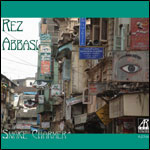 AAJ: And let's not forget that Ornette Coleman has one of the greatest gifts for melody on the planet.
AAJ: And let's not forget that Ornette Coleman has one of the greatest gifts for melody on the planet.
RA: Well, there you go. You can't underplay that. That doesn't hurt.
AAJ: "Bazaar —the song, not the album—has the trio augmented with Rudresh Mahanthappa's and Marc Mommaas's alto and tenor, respectively, and the whistling of Naren Budhakar. Despite the information provided by all the instruments, there's a lightness and spaciousness to the performance that's impressive. You're on sitar guitar here. This one really feels quite composed in its parts, with those interlocked alto/tenor lines. The solos are improvised, of course, but it's quite a performed composition in many ways. The way the intercoiled solo lines go into the final theme is wonderful. Tell me how such a piece is composed.
RA: That one was actually composed a number of years ago. I don't know if I should let the rabbit out of the hat, but it was. I sort of rejuvenated this one for this particular record because I wanted to have some guests on the record, and instead of making horn parts for, say, "Life Goes, I thought it'd be interesting to pull out this old one that I hadn't recorded. I even retitled it and everything.
That was actually composed without the guitar into a Doctor Rhythm machine.
AAJ: What's that?
RA: It's a little machine; it's got a guitar pad on it, and you can play it like you're playing guitar. Visually, it's like you're playing guitar, but you're actually playing something more like a piano. So I wrote onto this—now, I did switch a number of notes later on, but the main idea of the tune came from sitting and writing this tune on the sofa and really digging the whole process of playing it back right away. It's just of one those machines that have drum sounds, piano sounds, all kinds of stuff, and of course you can play it all back and hear it immediately. So that's the way I got that first emotional hit. And once I actually decided to record it, it really expanded, with the whistling and all that.
AAJ: I take it from what you just said that you do the majority of your writing on the guitar.
RA: Yeah. Virtually everything is played on the guitar. But the guitar's very limited in some ways, so I have to do other things, other techniques, to get away from the guitar. When I'm feeling like I'm done with a piece, reaching the end of a piece, I'll just sit at a café or someplace and just look at it for half an hour, just sing it through. Then I'll say, "Okay, what's missing? Then I'll take a step backwards. Once I know what's missing, I can go home and start drilling and, ideally, find out what the piece needs. So it's not a one-step process. For me, it's like a fifteen-step process [laughing].
AAJ: Well, it's good to get away from the instrument. It forces you to get away from what your fingers want to do, and just think of it as a piece of music.
RA: Exactly. And, you know, I'd love to be a great pianist. That would really help me. But I just don't have the time. I had to quit tablas for the same reason: I didn't have the time.
AAJ: Well, I assume you learned a great deal from the time you spent studying tablas, anyway.
RA: I did. You don't have to be a pianist or a tabla player to learn those aspects of music.
AAJ: I won't try to describe "Leather, but I think it's something that is very Rez Abbasi—something I would recognize as you, even if I heard it as something unidentified. It's got that deep quality of jazz and that profoundly Indian quality at the same time. Gautam's hand drum fits with Danny's playing very naturally; they're great together. And Kiran's vocal here is very unforgettable to me. I love how she blends with you and Gary on the head. Any thoughts?
RA: It was one of those pieces that I put through the mill; it took a little while to really justify it. I liked the melody in the beginning, but I really didn't think it was going anywhere. But after ten different processes of writing it, I came up with these little transition areas that really helped it move along, and I did realize that Kiran's voice really made it different. I also had Gary put these pretty heavy chords on top of the melody at one point.
So it ended up coming together really well. But it also came together as more of a studio cut. If anybody else plays the composition, it may not come out as well as it did on the record because of the fact that Gautam plays the mirdangam. That helped. The way I mixed certain things in the recording helped, too. It's a tune with a certain studio element to it, as opposed to something that's more purely live—which most of the other tunes on the record are. AAJ: Does that mean you don't play this tune live?
AAJ: Does that mean you don't play this tune live?
RA: I do play it onstage as well. Of course, when you hear live instruments, it always sounds different—everything does—so it comes off live sounding different from the record anyway. But it does hold its own live. I do think that if I had recorded it any differently than I did, it wouldn't have come off as well on record because of the postproduction I put into it.
AAJ: What, just the mix?
RA: Yeah. The particular cuts I chose of the mirdangam with Danny; bringing out the organ in certain parts, with those heavier chords; I brought up the guitar in some places and in other places I brought it down; I emphasized the way Kiran and I improvise at the end. You know, these things really help. Listening to music at home is a different experience than going out to the club. So why not know that, and use it, when you're mixing the record? People will be listening at home to this record. So it's not the same as just bringing the band into the studio and doing it live and saying that that's it. I use the studio as another musician, so to speak, on some cuts.
AAJ: I think that's something that most people who make really good records do. And you did co-mix and produce this record yourself. How did you develop your studio skills?
RA: Just by spending a lot of time co-mixing every record I've ever done. I mean, I love the engineers I work with; they're all great. But there can be a difference of opinion on some things. That's nobody's fault, but as a composer, I do feel that it's my responsibility to say, "I need this. I mean, I'm the one who wrote the tune, and I should know what it should sound like.
AAJ: Well, if even the world's best engineer does a lot of sessions—jazz sessions in particular—there is a tendency to do things the best possible way the same way every time.
RA: Oh, exactly. And to me, every record—in fact, every tune on a record—is a completely new experience, so I'm definitely not into having one mix for the whole record. That never works for my records. At least so far, anyway; maybe I'll do a trio record, just do standards or something, and it's a lot easier to just have one mix for something like that.
AAJ: "Mid-life is, to me, a very exciting and rhythmically terrifying piece with great use of all the voices: the trio plus soprano, alto and vocal. One of the best ones on the record, I think.
RA: Yeah, I really enjoy that one.
AAJ: There's a lot happening here, but I like how during the vocal line, which has your electric guitar playing around it, your overdubbed acoustic guitar provides the rhythm with Danny's tabla. Then during Rudresh's alto solo and your own liquid-toned guitar solo—lots of polyphony here—Gary's organ bass vamp is keeping it together before the kit goes into a completely different rhythm, very mixed meter, for Gary's solo. The way I describe it doesn't capture the overall cohesion of the song. How'd you write this one?
RA: I started writing it because I was in a project with a dancer who wanted me to write some tunes using some particular ragas. That's really a whole other discussion, so let's say they were scales (they weren't really ragas because scales and ragas are very different). So I took this one scale just to see what I could come up with, and so for the whole tune, the idea was to stick to this scale. That's one of the big things in Indian music—they stick to these sounds that evoke particular emotions. You don't try to move out of there.
AAJ: Is this a kind of modal thinking?
RA: Yes, but it's even beyond modal. It's like particular notes on particular beats. It's a whole science and art that I haven't been able to stick to, and that's why I just call it a scale here. The raga is where that underlying philosophy comes from. So I took this scale, and came up with the head, and I came up with this groove that's the intro. Then I had to decide where to go from there because those things only last about a minute! So I harmonized the scale and came up with a similar emotional content but with the band playing differently behind this area, which Kiran sings in. Then we take it into the solo section that Rudresh and I do, which is more like the beginning.
So I'm sticking to the scale to hold on to a particular feeling, but I'm also sort of adding different shades of that particular emotion—if that makes any sense. It's a little philosophical and hard to put into words; you have to hear it.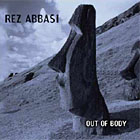 So that's basically how it came to fruition, and as I recall, the whole tune—outside of harmony parts—is in one scale. There's one area after we solo where I harmonize with myself and the two saxophones and that went outside of the scale. But the whole tune is pretty much in one scale, and you wouldn't really know that when you listen to it. And that was the challenge: to keep the whole thing moving—not have it be boring—over a nine-minute piece. Now that was for that dancer, but when I brought it to the band, I stuck to that idea. I thought I'd write another section using the same scale, just trying to keep it flowing. And I'm pretty happy with it. I think it does continue to flow.
So that's basically how it came to fruition, and as I recall, the whole tune—outside of harmony parts—is in one scale. There's one area after we solo where I harmonize with myself and the two saxophones and that went outside of the scale. But the whole tune is pretty much in one scale, and you wouldn't really know that when you listen to it. And that was the challenge: to keep the whole thing moving—not have it be boring—over a nine-minute piece. Now that was for that dancer, but when I brought it to the band, I stuck to that idea. I thought I'd write another section using the same scale, just trying to keep it flowing. And I'm pretty happy with it. I think it does continue to flow.
You know, sometimes you'll hear compositions where after something is said and done, the composer will drift over to a whole other section that might be almost irrelevant to what's already happened. That can be a flaw sometimes; you might not want to use that other thing just because you can't develop what you just played.
AAJ: It's like writing a movie and not knowing how to end it, so you just have everything blow up.
RA: Yeah. And having things blow up even before the ending. And you can say the same thing about improvisation. When people solo, it's very important to connect the ideas and not just jump from one thing to the next. In that sense composition and improvisation are very similar. You can use one to help the other, that's for sure.
AAJ: "Hindu-Myth is quite epic, and Danny's, of course, magnificent all over it, whether it's that 4/4 shuffle that begins the piece to his rhythm vocal scat alternating with his kit breaks farther on.
RA: I never thought of it as a shuffle, but that's interesting! I certainly don't mind putting elements of the tradition right in front, so I'm glad you hear it as a shuffle.
AAJ: I love how your four-note guitar phrase during that scat section provides so much tension. There's something very anxiety-provoking about it, and it pushes the tune into your own searing guitar solo where Gary's organ takes up that same phrase.
RA: Yeah. That's a fun tune. That was inspired by Paul Hindemith, the German composer. Only as a freshman in college was I introduced to 20th-century orchestral music. I already knew Mozart and all that stuff—we know that as kids—but when I went to college my teachers were saying, "You've got to listen to this and that and this. So I heard a piece—I think it was the first one I listened to—called "Mathis der Maler. And in it, Hindemith uses these open fourths and fifths, these intervals that I'd actually been working with on the guitar.
But on the guitar it sounds like one thing, and when you have thirty violinists and the whole orchestra doing it, it was something else entirely! I didn't know that this stuff could sound so huge. He was very into that kind of thing and it just floored me. It just felt like another sound world that I had to get into. You remember your first experiences a lot, and that one stuck with me.
So that was the inspiration. I used a lot of fourths in that tune, and the way the melody opens up is inspired by 20th-century music, just in general. Of course, the "Hindu-Myth part—that came afterwards. I thought it was a fun game, just a play on words after that composer's name. But I was also influenced by people like Joseph Campbell who wrote a lot about myths and demystifying things—all that stuff. So that song is inspired by those two guys, and the whole Indian thing comes into play as well. It worked out well.
class="f-right">
Gigging and the Sitar Guitar
AAJ: How often does this band work?
RA: It's a matter of getting dates together and tours together. That's actually the most difficult thing to do—just finding dates that pay well enough for everybody to come out and do their thing. I guess for all the dates I've gotten, sixty percent they've been able to do it, and forty percent I have gotten subs. You know, Gary's been on the road with [John] Scofield and [John] Abercrombie and all kinds of people, and Danny's got his own equally crazy schedule as well. But surprisingly enough, if both can't do it, usually one of them can; and Kiran's in the band all the time, so I retain a similar sense with the music. Of course, it's going to be very different once you pull any of these guys out. But the audience doesn't necessarily know that, and the music lives the way it lives.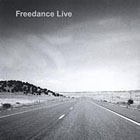 AAJ: Let me ask about the sitar guitar you play. I know almost nothing about this instrument, but I assume it's a fretted guitar with drone strings. Did you customize this yourself?
AAJ: Let me ask about the sitar guitar you play. I know almost nothing about this instrument, but I assume it's a fretted guitar with drone strings. Did you customize this yourself?
RA: Well, they are very much available. But I have customed mine out, so to speak. They do come with the drone strings, but I don't know if that droning helps the sound as much as me just wanting to play with the strings during the course of a tune. I tune it to particular compositions, and sometimes I'll comp with it. So it's not chordal; it's maybe a modal kind of sound. To me it's just like tenor saxophonists that use a soprano. It's another element to have onstage, and it has a unique, interesting sound. I'm not going to do a whole record with it, but it's something extra, like having an acoustic guitar. I don't see it as anything more than that. It makes me hear different things, just like an acoustic guitar does.
class="f-right">
Freedance and Kiran Ahluwalia's Group
AAJ: Tell me a bit about your work in bassist David Philips' group, Freedance, with drummer Tony Moreno and altoist John O'Gallagher. I loved the Freedance Live album, which came out, I think, in early 2006. I especially like the group's rhythm section under you and John. This is still a working band, I think.
RA: Well, that band's been together for thirteen or fourteen years, and of course it's very on-and-off because of the gig situation and the fact that everyone is working. It started out as a collective, and then Dave sort of took it over. He had some contacts in France, and we decided to just put it under his name. He is the main writer of the band, at this point. We might take off eight months and then get together and just do a one-week tour somewhere, and it sounds just as good as it ever did. And it's also gone to other levels as well.
It's a unique band. Everyone is that band is unique, and it just sort of exists under the radar alongside everyone's other projects. It's always there, and there's never any reason to quit—it's just always there for us. We're not ever touring with that band so much that it takes away from our other projects.
AAJ: Tell me about your role in your wife, Kiran Ahluwalia's own group.
RA: That's been really interesting, and I'm glad you asked that question. It's not a jazz group; it's a contemporary Indian music group. She sings and writes most of the music. There's a tabla player, a harmonium player, and I play acoustic guitar. We sit on a carpet in the traditional format with our knees crossed, and there we are, and we play for a couple of hours. I've learned a tremendous amount from her. I was playing Indian music before I met her, but the music she does is different from the classical Indian music; it stems from that, but it branches out. So now I know a lot more about the variety of Indian music—not just the classical.
We just did her new record, which is called Wanderlust. It's on the Times Square/World Connection label; it'll be out in May in Canada and in September in Europe and the United States. I arranged most of the music, and it's interesting because the microtonal quality kind of throws you for a loop. I'm harmonizing these melodies she's come up with, and when you harmonize something, you usually know the beginning note and the end note of a phrase—the beginning and end of a phrase.
With this, though, I would take the beginning and end notes and say, "Okay, it's a B minor chord. The problem is that between those notes, she's hitting other notes that aren't part of the twelve-tone system. So sometimes it becomes a B minor chord, and the next beat—literally—it's a B major chord! Then on the next beat, it's B minor again. So it was somewhat daunting to harmonize all these new melodies she's come up with, and I've learned a lot from that.
align=center>
Rez Abbasi with Kiran Ahluwalia
And the subtlety of the phrases—it's all just very different from what I've been taught in jazz music. With jazz we tend to play everything we know on every chord. We like to fancy ourselves as people that are able to do that. With Indian music, there's a real contrast. You milk certain emotions and phrases, and you don't veer away from those. So there are a lot of things I've learned from playing in her band, and, aside from that, touring with her band is interesting because we play world music festivals all over the place.
Recently, I just played with the slide guitar master Vishwa Mohan Bhatt. He's quite the heavyweight, one of the elite classical musicians, and I got to play with him at a festival. We were actually trading phrases in a solo improv, and afterwards, I was like, "Holy crap! The slide sounds so different from the acoustic where you're plucking the notes—there's so much more timbre resonating with the slide guitar. But it was interesting nevertheless. And I've also played with Celtic musicians, Sufi musicians. There's a lot of that going on at these festivals, and who knows how that influences me. It just subconsciously gets in there, so I'm hoping that it comes out in my own music.
AAJ: I don't see how it couldn't.
RA: I think not. But you have to allow yourself to let it come out, and that's why I don't like to just think of myself purely as a 100-percent jazz musician. I would say I'm definitely, ah, 75-percent [laughing]. But there's this other 25-percent that's just open to everything. And it's important to allow that to happen.
class="f-right">
Jazz Players of Indian Descent: a Movement?
AAJ: It could be said—generally by writers like myself, of course—that people like you, pianist/composer Vijay Iyer, and Rudresh Mahanthappa have all incorporated your cultural backgrounds into the western music (jazz) that you all play. I certainly don't think you're all the same—I'm not thinking there's some kind of homogeneity to your work just because you're all of Indian descent —but I am curious whether you see this as any sort of movement. Or should everyone incorporate who they are into the music they play?
RA: Well, the media usually make it a "movement. I don't think any of us is trying to consciously make any sort of movement, but we are incorporating our roots into what we do. That's probably more the case here. And we're around the same age, New York is bustling with creativity, and it's just the obvious thing to do—especially with Indian music. I'm not biased against any other music, obviously, but Indian music has such an improvising element. And the science of the rhythm ideas is endless. So as a jazz musician, how can you not take advantage of another music that's so open-ended? I've also checked out Chinese music, Brazilian music, and those also offer lots of forms that can be inspirational.
Really, it's just the music that comes out when people do look to their roots to see what could influence the jazz music that they play. [Pausing] I think.
class="f-right">
Influences
AAJ: Your playing, I am happy to say, doesn't remind me of anyone. Some of the acoustic voicings on the song "Thin Elephant made me think of Pat Metheny, but that's really the only thing I've heard in your music that reminded me specifically of another player, and that association might not even have been apt. What are your biggest musical influences?
RA: Let me just start by saying that when I was sixteen years old, I saw [guitarist] Joe Pass, the first jazz person I ever saw play. And in the very next month, I saw [guitarist] Allan Holdsworth. So you have these opposites, basically, within the jazz framework, and that really became this sort of paradigm. I saw these two guys play, and I was blown away by each of them in very separate ways.
After that, I started studying with this guy named Paul LaRose, who's now deceased. The first two solos he made me learn were Miles Davis' "So What and Pat Martino's "Impressions. Again, two very opposing elements—completely different solos. I guess I'm trying to get at the fact that a lot of the music I like to listen to is often the stuff that I don't necessarily love right away. It's sort of the opposite of what's obvious to me.
I listen to Keith Jarrett. I've listened to Coltrane, Metheny, everyone in jazz. But there's also this feeling I have that I've got to start listening to things that I don't feel so comfortable listening to. So I started listening to U2. I've been listening to [Malian Afropop singer/songwriter] Salif Këita, and he's just unbelievable. You know, usually you think of these things as commercialized music, but a lot of these people are unbelievable. [Guitarist/producer] Michael Brook with [Pakistani Qawwali singer] Nusrat Fateh Ali Khan—those are some records where I just can't believe how great both the production and emotional elements are.
So I started listening to a lot of non-jazz records a few years ago, and I think that's really influenced my composition because you hear these records where these guys aren't really improvising much at all. But the songs are six minutes long, and I'm floored the whole time. AAJ: Well, a lot of these people write good songs, and the players making these records are often very good. You'll find people who have fantastic time, people with a lot of emotion. I really don't distinguish between kinds of music.
AAJ: Well, a lot of these people write good songs, and the players making these records are often very good. You'll find people who have fantastic time, people with a lot of emotion. I really don't distinguish between kinds of music.
RA: Yeah. So I'm trying to incorporate some of the things I've heard that they've done in terms of composition. These guys have so many variations; they've got so many elements. And when you add improvisation to that, it's quite astounding. So anything that comes to me, I'll listen to. And if what I'm listening to is just too easy for me to listen to, I'll just go listen to the opposite thing.
AAJ: What are you going to do this year?
RA: I'm going to finish mixing Kiran's record. And it's a really wonderful record. I've got some offers to do some other types of projects. I'm thinking of composing some new material for some other projects of mine. And that takes a whole certain mindset, and I'm not there yet. I need to weed out some other things I have to do, and just start writing. And I'm also just trying to [laughing] clean my apartment!
Selected Discography
Rez Abbasi, Bazaar (Zoho, 2006)
Freedance, Freedance Live (Street Sound, 2005)
Rez Abbasi, Snake Charmer (Earth Sounds, 2005)
Kiran Ahluwalia, Kiran Ahluwalia (Triloka, 2005)
Sunny Jain Collective, Mango Festival (Zoho, 2004)
Dave Williams & Freedance, Prayer (Sound Street, 2003)
Rez Abbasi, Out of Body (Feroza, 2002)
David Phillips & Freedance, David Williams & Freedance (Naxos, 2000)
Rez Abbasi, Modern Memory (Cathexis, 1998)
Rez Abbasi, Third Ear (Ozone, 1994)
Photo Credits
Second Photo: Sanja Antic
Courtesy of AAJ Visual Arts Gallery
All Others: Rez Abbasi
Tags
PREVIOUS / NEXT
Rez Abbasi Concerts
Support All About Jazz
 All About Jazz has been a pillar of jazz since 1995, championing it as an art form and, more importantly, supporting the musicians who make it. Our enduring commitment has made "AAJ" one of the most culturally important websites of its kind, read by hundreds of thousands of fans, musicians and industry figures every month.
All About Jazz has been a pillar of jazz since 1995, championing it as an art form and, more importantly, supporting the musicians who make it. Our enduring commitment has made "AAJ" one of the most culturally important websites of its kind, read by hundreds of thousands of fans, musicians and industry figures every month.









